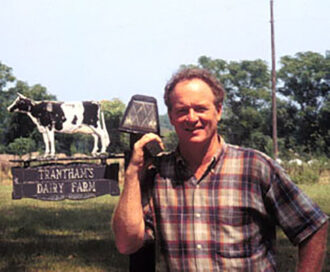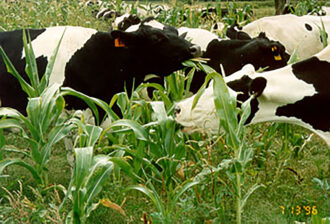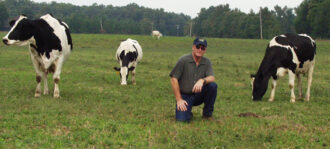GRIFFIN, Georgia – Tom Trantham once humbly emphasized that he was a dairy farmer, with the accent on farmer, and not a grazier. But to livestock producers, he was a rock star.
The well-known South Carolina farmer, who recently passed away, began his operation over four decades ago the conventional way – a confined feeding system with chemicals and siloed grain. But through a simple accident, Trantham had made rotational pasture grazing a household name.
Those who knew Trantham remember the story: With a farm business teetering on collapse, his small herd of Holsteins saved the day.
Facing stagnant milk prices and skyrocketing feeding costs, Trantham was on the verge of bankruptcy. His cows couldn’t produce enough milk to pay for the feed bill, which ate up 65 percent of the gross income. "Financial advisors told me to get out of the business," he once recalled. "They said there was no way for me to make it. Those were dark days; I'd wake up and think maybe the place had burned down or all the cows had died in the night and I'd be free."

Then one April day in 1989, as if by fate, the cows broke through the confinement feeding area into a seven-acre field of lamb’s quarters, rye grass, clover and fescue – a field that was scheduled for chemical burndown. “I was disgusted,” recalled Trantham.
Much to his surprise, however, the milk production increased – two pounds on average per cow. That was 184 extra pounds of milk from 92 cows by simply grazing a field. Thinking the cows might be on to something, Trantham opened his fields up again to grazing. The result: Another five pounds of milk per cow per day. As the summer heated up, production slowed, but the seed of a continuous rotational grazing system was planted. Could Trantham save his farm?
Enter Sustainable Agriculture Research and Education (SARE), a USDA program that supports research in sustainable agriculture practices. In 1993, Trantham collaborated with Clemson University researchers Jean Bertrand and Fred Pardue in a Research and Education Grant project (LS93-054, “Evaluation of a Low-input, No-till, No-herbicide Continuous Grazing System for Dairy Cows") to study year-round rotational grazing using sustainable agriculture techniques.
Results showed that grazing cows instead of harvested feed translated into cost savings, over $9,600 for an average of 70 cows that grazed a total of 292 days. Additionally, the study found that cattle that graze consume a higher quality product, choosing the lushest, most nutritious parts of the plant and leaving the least digestible parts. Had the cows been fed the same crops as harvested feed, they would have been fed a much lower quality product and would have had to expend energy digesting lower quality forage.
The study affirmed Trantham’s observations with scientific data; profits continued to improve the further Trantham moved away from conventional dairying. The Twelve Aprils Dairy model was born. He taught others how to develop a year-round rotational grazing system packed with a succession of crops that the cows wanted, were more nutritious than harvested crops, and boosted milk production.

Trantham became an advocate for South Carolina agriculture, giving farm tours and speaking at agriculture events across the country. He reached youth through a children’s book that told the story of his farm. He served on the SSARE Administrative Council as a Producer member and worked closely with state and regional sustainable agriculture professionals for many years blazing the trail for other small livestock producers to follow.
Many within the SSARE program looked upon Trantham as a pioneer and fierce advocate of sustainable agriculture.
SSARE program director Jeff Jordan remembers Trantham fondly. “I got to know Tom when he became one of the first farmer members of our Administrative Council to chair the committee. Tom was an original -- an original thinker, farmer and, most of all, person. It was a joy to work with Tom and he will always be remembered as one of SARE’s original stars.”
Said Sam Houston State University rural sociologist Doug Constance, who was a long-standing chair of the SSARE Administrative Council, "Tom Trantham's Twelve Aprils Dairy system was the innovation for sustainable dairy systems in the South. Tom served Southern SARE long and well."
Through a Professional Development Program Grant (ES98-039, “Multi-disciplinary Training on Pasture-based Dairy Systems”), Trantham continued to improve his Twelve Aprils Dairy model. He readjusted his paddock size to allow faster crop regrowth, installed a $10,000 irrigation system to combat drought, and conserved the environment by collecting manure to spread back onto the fields as fertilizer -- techniques that he would have considered reckless in the days when money would have been invested more in feed supplements.
Trantham even tested various ground covers to ease stress on cattle as they traveled to grazing paddocks (FS99-102, “Cattle Lane Construction Alternatives that Enhance Intensive Grazing Systems”).
Trantham saved his farm and, no doubt, helped other livestock farmers save theirs. His rotational grazing model is now a staple of livestock production for small farmers.
"Tom Trantham was an innovator and leader in the development of the present day sustainable agriculture movement and SARE," said former SSARE AC Producer member Nancy Roe, who briefly worked with Trantham in the SARE program. "The methods and practices he developed and taught have been adopted by several generations of dairy producers who are working towards agricultural sustainability. He was a courageous farmer and an important teacher of sustainable agriculture."
Farmers, like Tom Trantham, are the reason why the SARE program exists. Its purpose of increasing profitability, protecting the environment, and improving qualify of life is embodied in Trantham’s determination and success. Through his on-farm research, Trantham learned that solutions present themselves in unexpected ways. “A lot of times, the questions we ask…the answer is not what we were looking for,” recalled Trantham.
For over three decades, the SARE program has provided farmers the resources to turn their innovations, their ideas, their hunches, perhaps even their dreams into long-term strategies to produce and distribute food, fuel and fiber more sustainably.
For Trantham, his vision of shedding the last vestiges of the old confinement dairy was fully realized in 2002. The farm silo, which had no place in his herd’s new life, was turned into a milk bottling plant and on-farm store.
It is a place now well-known, appropriately named Happy Cow Creamery.
Learn more about the Twelve Aprils Dairy system
To learn more about funeral services or to share a memory of Tom Trantham, visit Gray Mortuary.
Published by the Southern Region of the Sustainable Agriculture Research and Education (SARE) program. Funded by the USDA National Institute of Food and Agriculture (NIFA), Southern SARE operates under cooperative agreements with the University of Georgia, Fort Valley State University, and the Kerr Center for Sustainable Agriculture to offer competitive grants to advance sustainable agriculture in America's Southern region. This material is based upon work that is supported by the National Institute of Food and Agriculture, U.S. Department of Agriculture, through Southern Sustainable Agriculture Research and Education. USDA is an equal opportunity employer and service provider. Any opinions, findings, conclusions, or recommendations expressed in this publication are those of the author(s) and do not necessarily reflect the view of the U.S. Department of Agriculture.
